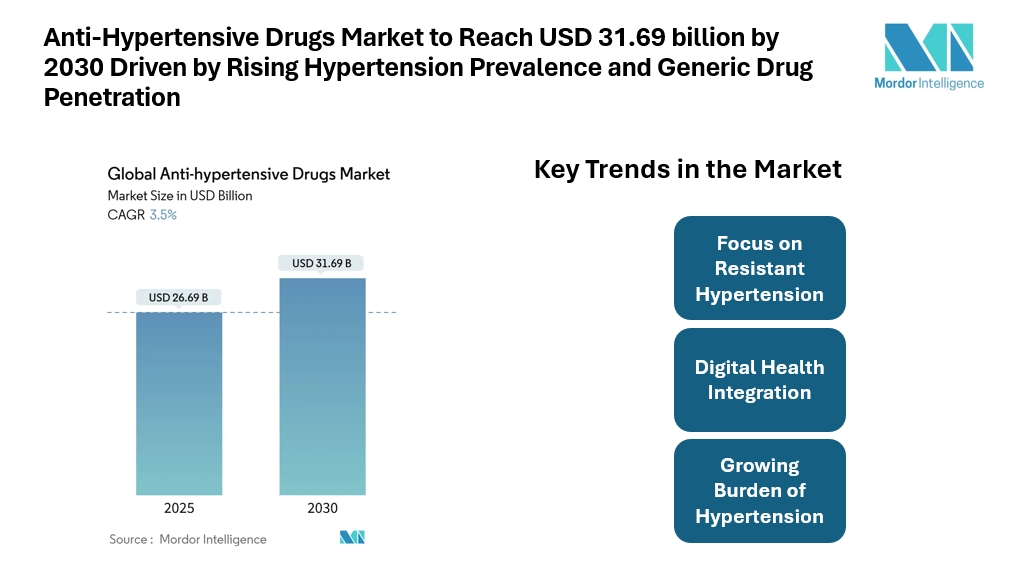Introduction
The anti-hypertensive drugs market is valued at USD 26.69 billion in 2025 and is forecast to reach USD 31.69 billion in 2030, advancing at a 3.5% CAGR. Hypertension remains a leading risk factor for cardiovascular diseases and stroke, demanding consistent therapeutic innovation and accessibility. Market growth is underpinned by the increasing number of diagnosed patients, the introduction of combination therapies, and government-backed preventive healthcare programs.
Pharmaceutical companies are focusing on novel formulations that enhance patient compliance, such as extended-release tablets and fixed-dose combinations. The rise of home blood pressure monitoring and digital prescription tracking also supports adherence, improving the long-term efficacy of medication regimens. However, generic competition continues to challenge the pricing landscape, compelling major firms to diversify portfolios and invest in differentiated drug delivery systems.
Key Trends in the Anti-Hypertensive Drugs Market
-
Growing Burden of Hypertension: Sedentary habits, dietary imbalance, and increasing obesity levels contribute to a growing global patient base, particularly in developing economies.
-
Rise of Combination Therapies: Physicians increasingly prescribe fixed-dose combinations to simplify treatment schedules and improve outcomes, expanding their share within the anti-hypertensive drugs market.
-
Generic Drug Expansion: The expiry of patents for several branded antihypertensives has triggered a surge in low-cost generics, especially in Asia and Latin America, broadening patient access.
-
Focus on Resistant Hypertension: A subset of patients remains unresponsive to traditional drug classes. Research into new mechanisms—such as aldosterone antagonists and endothelin receptor blockers—is advancing treatment effectiveness.
-
Digital Health Integration: Mobile-based adherence monitoring, telemedicine consultations, and remote diagnostics are becoming standard in hypertension management, enhancing patient engagement and treatment continuity.
Check out more details and stay updated with the latest industry trends, including the Japanese version for localized insights: https://www.mordorintelligence.com/ja/industry-reports/anti-hypertensive-drugs?utm_source=abnewswire
Market Segmentation
The anti-hypertensive drugs market is segmented based on drug class and distribution channel, reflecting diverse therapeutic strategies and patient access models.
By Test Type (Value)
-
Culture-based Tests
-
Smear Microscopy
-
Nucleic Acid Amplification Tests (NAAT)/PCR
-
Interferon-Gamma Release Assays (IGRA)
-
Tuberculin Skin Test (Mantoux)
-
Radiographic & Imaging Tests
-
Other Tests
By Technology (Value)
-
Culture-based
-
Molecular Diagnostics (PCR/NAAT)
-
Immunoassays (IGRA/LAM)
-
Radiology/X-ray
-
AI-enhanced Digital Microscopy
-
Others
By End-User (Value)
-
Hospitals & Clinics
-
Diagnostic Laboratories
-
Academic & Research Institutes
-
Others
By Geography
-
North America
-
Europe
-
Asia pacific
-
South America
-
Middle east&Africa
Regional analysis highlights that North America retains a substantial market share owing to established healthcare infrastructure, insurance penetration, and awareness programs, while Asia-Pacific shows rapid market growth fueled by government health initiatives and generic drug manufacturing capacity.
Key Players in the Anti-Hypertensive Drugs Market
The competitive landscape features both multinational pharmaceutical leaders and regional generic manufacturers focused on cost-effective formulations.
-
Pfizer Inc.
-
C.H. Boehringer Sohn AG & Ko. KG
-
Noden Pharma DAC
-
Daiichi Sankyo Company Limited
-
Merck KGaA
Strategic partnerships between global innovators and local distributors continue to enhance availability across under-served regions. Companies are also exploring patient-assistance programs to improve medication adherence rates in low-income populations.
Conclusion
The anti-hypertensive drugs market continues to evolve in response to demographic shifts, clinical research advances, and affordability mandates. While mature markets sustain steady replacement demand, emerging economies are expanding access through cost-efficient generics and government intervention. The emphasis on multi-drug combinations, personalized therapy approaches, and telehealth integration positions the market for steady long-term growth.
As cardiovascular disease prevention remains a global public-health priority, the outlook for anti-hypertensive drugs market growth remains positive. Pharmaceutical innovation, combined with digital adherence tools and expanding distribution networks, will help address the persistent gap between diagnosis and sustained blood-pressure control.
Industry Related Reports
Cardiovascular Drugs Market: The Cardiovascular Drugs Market Report Segments Into by Drug Class (Anti-Hyperlipidemics, Anti-Hypertensives and More), by Indication (Hypertension, Coronary Artery Disease and More), by Route of Administration (Oral, Injectable / IV and More) By Distribution Channel (Hospitals, Pharmacies and More), and Geography (North America, Europe, Asia-Pacific, and More).
Angina Pectoris Drugs Market: The Angina Pectoris Drugs Market is Segmented by Therapeutic Classes (Beta Blockers, Calcium Channel Blockers, Nitrates, Angiotensin-converting Enzyme Inhibitors (ACE Inhibitors), Anti-Platelets, and Others) and Geography (North America, Europe, Asia-Pacific, Middle East and Africa, and South America). The report offers the value (in USD million) for the above segments.
Pulmonary Arterial Hypertension Market: The Pulmonary Arterial Hypertension Market Report is Segmented by Drug Class (Prostacyclin and Prostacyclin Analogs, and More), Route of Administration (Oral, Intravenous, Subcutaneous, and More), Drug Type (Branded and Generic), Distribution Channel (Hospital Pharmacies, and More), and Geography (North America, Europe, Asia-Pacific, and More).
About Mordor Intelligence:
Mordor Intelligence is a trusted partner for businesses seeking comprehensive and actionable market intelligence. Our global reach, expert team, and tailored solutions empower organizations and individuals to make informed decisions, navigate complex markets, and achieve their strategic goals.
With a team of over 550 domain experts and on-ground specialists spanning 150+ countries, Mordor Intelligence possesses a unique understanding of the global business landscape. This expertise translates into comprehensive syndicated and custom research reports covering a wide spectrum of industries, including aerospace & defense, agriculture, animal nutrition and wellness, automation, automotive, chemicals & materials, consumer goods & services, electronics, energy & power, financial services, food & beverages, healthcare, hospitality & tourism, information & communications technology, investment opportunities, and logistics.
For any inquiries or to access the full report, please contact:
media@mordorintelligence.com https://www.mordorintelligence.com/
Media Contact
Company Name: Mordor Intelligence Private Limited
Contact Person: Jignesh Thakkar
Email: Send Email
Phone: +1 617-765-2493
Address:11th Floor, Rajapushpa Summit, Nanakramguda Rd, Financial District, Gachibowli
City: Hyderabad
State: Telangana 500008
Country: India
Website: https://www.mordorintelligence.com/

